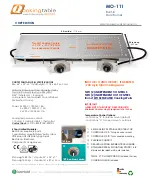
9
1. Antes de conectar el tanque, asegúrese de que la válvula de control del regulador esté cerrada. Efectúe una prueba con
agua jabonosa cada vez, antes de usar la unidad.
2. Abra la válvula del tanque. Coloque un fósforo encendido bajo el protector contra el viento. Gire lentamente la perilla en el
sentido de las agujas del reloj, hasta que se encienda el quemador. (Si el quemador no se enciende en 5 segundos, apa-
gue la válvula de control de regulador y luego el tanque). Espere 5 minutos hasta que se disipen los vapores, y vuelva a
encender el quemador.
Si llama se apaga, espere 5 minutos a que se disipen los vapores y volver a encender el quemador.
3. Cuando se haya encendido el quemador, abra la válvula del regulador hasta que aumente la llama. Con el regulador de
aire, regule la llama hasta que se ponga de color azul. Disminuya el nivel de la llama.
4. Llene la olla con agua o aceite. No la llene a más de un tercio de su capacidad. Esto ayudará a evitar que la olla se
desborde. Nota: NO ponga una olla vacía sobre las llamas al descubierto. Eso dañará la olla.
5. Caliente el agua o el aceite a la temperatura deseada, regulando la válvula de control del regulador.
La temperatura del
aceite nunca debe sobrepasar los 400° F (204° C). El aceite se enciende a temperaturas entre 550° F (287° C) y 700°
F (371° C).
6. Siempre use un termómetro para cocinar.
7. Después de cada uso, primero apague la válvula de control del regulador; luego, desconecte el tanque. Deje que la base
de la cocina y la olla se enfríen completamente antes de tocarlas, moverlas o guardarlas.
APAGADO
ENCENDIDO
CONEXIÓN DE TIPO 1
AL TANQUE DE GAS
EN EL SENTIDO DE
LAS AGUJAS DEL
RELOJ
EN SENTIDO
CONTRARIO A LAS
AGUJAS DEL RELOJ
Inspeccione la manguera antes de cada
uso.
Si muestra señales de desgaste, cortes o
fugas, cambie la manguera y el regulador por
uno de modelo 903070013.
EN SENTIDO
CONTRARIO A LAS
AGUJAS DEL RELOJ
OPERACIONES DE LA VÁLVULA DE CONTROL DEL REGULADOR
CONEXIÓN DEL REGULADOR A LA VÁLVULA DEL TANQUE
CONTROL DEL REGULADOR
AJUSTE DE LA
LLAMA
La válvula de control del regulador se usa para
regular la llama del quemador. El girar la perilla de
control en el sentido de las agujas del reloj permite
aumentar lentamente la llama del quemador, y en
el sentido contrario a las agujas del reloj permite
reducirlas hasta apagar el quemador.
EN EL SENTIDO DE
LAS AGUJAS DEL
RELOJ
El gancho del regulador se usa para mantener el regulador
separado de la tierra cuando no está conectado al tanque.
Fíjelo a la unidad, como se ilustra
Los reguladores de tipo 1 tienen un gancho, como se ilustra.
A
MARILLA
A
ZUL
L
LAMA
CORRECTA
L
LAMA
INCORRECTA
INSTRUCCIONES PARA ENCENDER EL QUEMADOR
POSICIÓN DE
ENCENDIDO
ORIFICIO DE OBSERVACIÓN
DE LA LLAMA
ENCENDIDO
APAGADO
Ajuste el regulador de aire al quemador, hasta que
la llama del quemador sea lo más azul posible
Regulator Control Valve
Soapy Water Test Warning and Procedures
• The Soapy Water Test must be performed each time gas cylinder is connected to appliance or
each time the appliance is used.
• The Soapy Water Test must be performed outdoors in a well-ventilated area.
• When performing the Soapy Water Test, always keep cooker away from open flames, sparks, or lit
cigarettes.
• This Outdoor Gas cooker is designed to operate with propane gas only. This product will not
operate with natural gas.
• Never use an open flame to test for gas leaks.
• Always remove any cookware from cooker stand when performing the Soapy Water Test.
PROCEDURE:
1.Remove any cookware from your cooker stand.
2. Turn regulator to OFF position, and turn the gas cylinder valve to the OFF
position.
3. Prepare your soapy water solution by combining (1) one part dish washing
liquid with (3) three parts water to test for the possibility of any gas leaks in the
hose or connections to regulator and the regulator connection to gas cylinder.
Apply soapy water solution to the gas cylinder valve, regulator and along the
hose to the burner.
4. Turn gas cylinder valve ON (regulator control valve should be in the OFF posi-
tion) and observe gas cylinder valve for bubbles. DO NOT LEAVE GAS ON
FOR MORE THAN 12 SECONDS. If bubbles appear, stop, turn gas cylinder
OFF, and retighten the fitting. Repeat test.
5. When the gas cylinder has been tested, open the regulator control valve one full
turn and check for bubbles at regulator control valve, along the entire length of
hose and at the connection to the burner. DO NOT LEAVE GAS ON FOR
MORE THAN 12 SECONDS. If soapy mixture starts bubbling, gas is leaking
through the connection or hose. Turn the regulator valve OFF and then the gas
cylinder OFF and retighten the connection that is leaking gas. After test is
complete, and there are no leaks, wait a minimum of 5 minutes for gas fumes
to diminish before lighting cooker.
DURING ANY PORTION OF THE SOAPY WATER TEST, IF BUBBLES CONTINUE TO
APPEAR, STOP, DO NOT USE THE APPLIANCE AND CONTACT YOUR LOCAL PROPANE
DEALER OR MASTERBUILT AT 1-800-489-1581.
NOTE: USE A 20 LB (9KG) CYLINDER WITH A PROTECTIVE COLLAR WITH THIS
APPLIANCE. ONLY CYLINDERS MARKED “PROPANE” MUST BE USED.
Bubbles in Soapy Water Test
Burner, Hose and orifice
Connection
Burner, Hose, Regulator and
Cylinder Valve
10

































